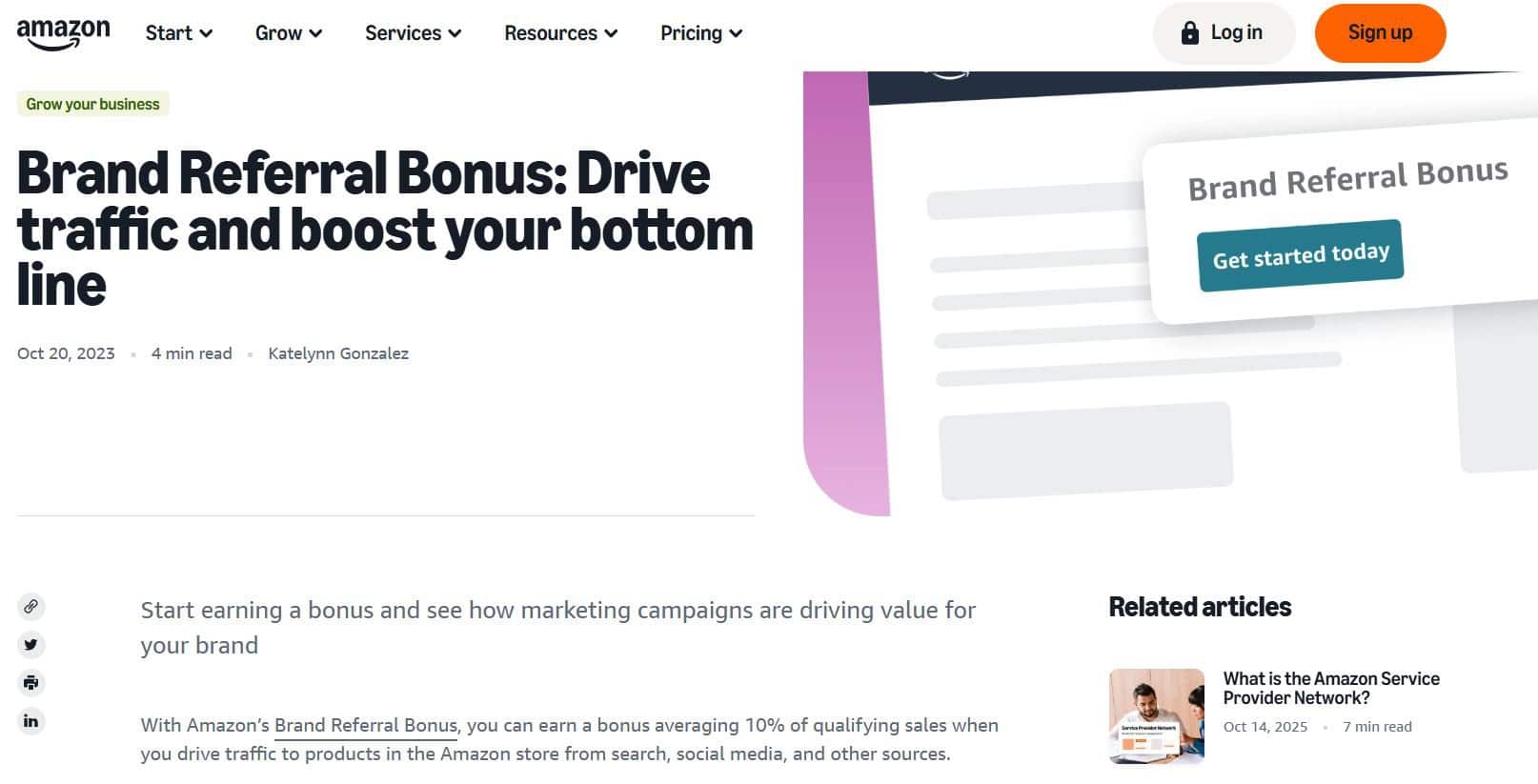Last Updated on November 18, 2025 by Ewen Finser
Amazon isn’t short on competition. Over two million active sellers push more than 600 million products, all fighting for the same eyeballs. That sheer volume is both the opportunity and the problem: it’s where the customers are, but it’s also where every rival brand is fighting you back.
For years, doing well came down to two things: keywords and sales velocity. Then Amazon switched from the A9 to the A10 algorithm, and things changed. Today, the platform rewards momentum; if your listing looks alive with steady traffic and rising conversions, Amazon pushes you further up the ladder. If not, you sink, no matter how carefully you’ve stuffed your backend keywords.
Luckily, the blueprint for cracking external traffic is already out there, so in this article, I’ll break down what works, what doesn’t, and how successful sellers are growing their stores even when things look bleak.
Why You Need External Traffic Now
When the A10 update came out, Amazon stopped grading listings only by what happens on Amazon. This is when traffic from Google, YouTube, TikTok, blogs (essentially humans coming from the outside world) started being more important. Bring shoppers with you, convert, and Amazon will put you higher on the ladder.
You can see this change of logic in Amazon’s own breadcrumbs:
- 2018 > Amazon Attribution in beta (I got access on a client account; the data wasn’t perfect, but it was the first real window into off-Amazon impact).
- 2019 > Attribution opens up widely. No more guessing which Facebook/Google campaign sells units on Amazon.
- 2021 > Brand Referral Bonus launches. Up to ~10% back on sales you drive from outside. Amazon literally pays you to send traffic.

So why does this matter? Because PPC costs keep going up, and external clicks can be cheaper and more strategic. A well-targeted YouTube video, a Reddit post in the right sub, a blog roundup with intent-heavy keywords all convert, and when they do, A10 responds accordingly.
It’s why I think that relying only on Amazon PPC in 2025 is an outdated strategy. Useful? Sure. Sufficient? Not anymore. The most successful sellers today use external traffic on top of dialed-in listings and let Amazon’s algorithm amplify the effect.
Internal Traffic Still Works (But it’s Not Enough)
Amazon search is still the primary driver of sales. Most buyers start at the search bar, and if your listing has any traction, you’ll see the compounding effect: more clicks, more conversions, better placement… and back the same way. It’s the circle of life!
The problem is momentum. Once a category has entrenched sellers with thousands of reviews and daily sales, staying visible becomes harder for everyone else. New products rarely get the oxygen they need if they only rely on Amazon’s internal loop.
But clicks and conversions from outside Amazon both add sales and feed directly into A10’s ranking logic. Traffic from outside the marketplace pushes you higher inside it. That’s why a bit of diversification with Google ads, influencers, or email lists often outperforms competitors who never leave the Amazon sandbox.
Put simply, if you’re only managing internal rules, you’re giving incumbents the advantage. External traffic is how newer listings prove their value and earn a shot at page one.
What External Traffic Does for you
I used to think PPC alone could carry a launch. Back when bids were cheaper, you could brute force your way into visibility and hope sales velocity kept you afloat. That stopped working once CPCs started going up and every category got saturated.
What actually moved the needle was external demand. The first time I ran a simple Google Ads campaign pointing to an Amazon listing, I saw conversions spike. Not because the clicks were magic, but because Amazon suddenly treated the product as “hot.” Sales velocity shot up, organic rankings followed, and my PPC campaigns got cheaper overnight.

It’s so easy to overlook this, but external clicks aren’t just extra sales; they change how Amazon’s A10 algorithm sees you. When traffic comes in from outside, converts, and keeps coming it shows that your product deserves to be higher in the SERPs.
With the addition of Brand Referral Bonus you’re also no longer absorbing the full cost of those external ads (more on that later). So, between lower CPC, higher conversion, and cashback, external traffic often ends up more profitable than internal ads.
Core Traffic Levers
I’ve tested almost every channel under the sun to send traffic to Amazon listings. Some worked, some burned money, and some were absolute bangers. Here’s where I’d keep my attention if I had to start from scratch today.
4.1 Optimize your Listing Before Sending Traffic
Far too often, I see sellers who blow thousands on ads only to send people to listings that look like half-finished drafts. It doesn’t matter how good your targeting is if the page sucks; you just paid for clicks that will never convert.
Before I send a single visitor, I make sure the title is crystal clear, bullets are skimmable, and images don’t look like they were taken on a Nokia. A+ content isn’t fluff either — Amazon rewards it. I’ve also used PickFu to test titles and hero images. One client’s conversion rate almost doubled over a period of a few weeks just from swapping an image after a PickFu poll.

4.2 PPC (Amazon + External)
Amazon PPC still works, but I think Sponsored Display is the underdog that many sellers sleep on. Its retargeting follows shoppers around the internet and has saved me more launches than I can count.
On the external side, I’ve run Google Ads that outperformed Amazon’s own placements for high-intent searches. Facebook and Pinterest can be hit-or-miss, but when you nail the creative, the Brand Referral Bonus makes the math work. Pro tip: don’t copy-paste your Amazon keywords into Google. Shoppers type differently there. I learned that the hard way, burning through $500 before realizing “best ___” queries crushed, while single-word keywords bled cash.
4.3 Influencers and Affiliates
Influencer traffic is hands-down the highest-leverage strategy I’ve seen. I’ve had campaigns where a single YouTube gear review kept a product running for months without a single ad dollar. Affiliates only amplify that because they have skin in the game. Neil Patel’s ROI stat ($23 for every $1 spent) actually makes sense with what I’ve seen in practice.
Finding and managing them used to be a nightmare until I started using Referazon. If you’re serious, I advise you to get organized from the start. And if you want Amazon-specific ROI tracking baked in, Levanta is one of the few tools I’d easily recommend. It shows you exactly which creators made sales and pays them automatically. That single source of truth is worth every penny.

4.4 Organic Social
This one is a grind. I’ve wasted weeks polishing Instagram grids that looked great but barely reflected on sales. The only platforms, from my experience, that consistently send clicks are Pinterest, TikTok, and Facebook.
Stick to the 80/20 rule: 80% value, 20% promo. The day I stopped blasting promo posts and started posting “how-to” content around my niche, engagement shot up and traffic followed.
4.5 Email & Owned Channels
Owned traffic is the only real insurance policy. Launches can tank on Amazon PPC, but still get bailed out by the email list. The idea is to run traffic to a landing page, grab the email with a discount, then pass them through to Amazon with an Attribution link. That way you still build a list Amazon can’t touch. Long-term, this channel has the best ROI of anything I’ve tested.
4.6 Video
YouTube alone sends nearly 60% of social referrals to Amazon, and simple unboxing videos can outrank polished product demos because authenticity trumps production. On top of that, YouTube videos also rank on Google. That means one video can work double duty for both search engines. If you’re not doing this, you’re letting competitors scoop free traffic.
4.7 Community Plays
Communities are slow to build but pay dividends forever. I’ve dropped links into Reddit threads that brought more qualified traffic than a $1,000 ad run. Same with Facebook groups; once trust is built, every new product launch becomes 10x easier.
More than just about volume, the mindset should be about the type of click. A Redditor who finds your product in a trusted thread is already halfway sold before they get to your listing.
Tracking and Measuring Results
For a long time, sending traffic to Amazon was a black box. You could throw money at Facebook or Google, see sales rise, and still have no clue whether those dollars moved the needle or just padded Amazon’s baseline growth. That changed with Amazon Attribution.

Attribution links finally give you line of sight into what’s happening after the click. You can see whether your Facebook ad got them to cart, whether your YouTube review converted, or whether that Google keyword you thought was golden is just a cash drain. The data isn’t perfect (I’ve seen lag and undercounts) but it’s miles ahead of the guessing we had to put up with.
The best thing is stacking Attribution with the Brand Referral Bonus. If you’re sending external traffic, Amazon now hands you up to ~10% back on every sale you generate. That’s Amazon literally paying you to prove you can bring shoppers from the outside world. I’ve run campaigns where that rebate basically covered the ad spend. It’s a different kind of math from that point on.
Lessons From the Field
The biggest mistakes I keep seeing are the same ones I made early on. First, sellers send traffic to listings that aren’t even conversion-ready. If your images look like they were shot on a flip phone, or you have no reviews, all that spend is much less effective. Second, they treat external channels like a carbon copy of Amazon PPC. Google keywords are not the same as Amazon keywords. TikTok audiences don’t click with the same intent as someone typing into the Amazon search bar. And third, they do not track their traffic, which is probably the biggest mistake of them all.
What works (and I’ve seen it with multiple brands) is a slower, more deliberate strategy:
- Start with one channel. Nail it before spreading yourself too thin by trying something else.
- Combine paid and organic so you’re not dependent on a single faucet.
- Repurpose assets everywhere. A product demo shot for YouTube can be used on TikTok, in email, and even as your main image stack.
Cambio Roasters, for example, made use of referral bonuses by driving traffic through email and affiliate partners, so that the 10% kickback made campaigns sustainable long term. The K-Cup brand went with external traffic through Pinterest ads (surprisingly cheap clicks) and Attribution showed those customers weren’t just one-off buyers.
The common thread is testing, tracking, and scaling what’s proven to work. You’ll almost always burn cash if you don’t stick to these simple rules.
The Tools for the Job
Back when I first started testing external traffic, tracking was an afterthought to most. You’d throw money at Facebook or TikTok, see a bump in sales, and convince yourself it worked (even if half of it was a coincidence). The problem was simple: there was no reliable way to see which clicks did the trick.
That’s changed over the last few years. Amazon Attribution finally opened the door, even if the data felt rough at first. Other tools helped too: Referazon made it easier to track affiliate pushes, and Levanta showed where clicks and conversions are coming from. With Levanta, I could see TikTok generating impressions but no sales, while Pinterest (the platform nobody on my team wanted to bet on) outperformed everything else. That kind of info shaved months off the trial-and-error game.
The best part is how campaigns tracked through Levanta also qualify for Amazon’s Brand Referral Bonus, but now the bonus is tied to verified results instead of broad strokes. I’ve had campaigns where the ~10% kickback covered a chunk of ad spend, while the data told me exactly where to double down.
Clicks don’t pay the bills, buyers do. If you’re not tracking at that level, you’re not running a business, you’re indulging in wishful thinking.
Levanta assembled this report to help digital merchants navigate the new AI-shaped buying journey. Discover why creators now drive the clicks AI can’t and how to turn that into revenue.
Time to Step Up
Amazon isn’t getting easier. More sellers, more reviews, higher PPC costs, the internal game alone doesn’t cut it anymore.
You can’t succeed just by spending big on ads. But if you have the discipline to optimize listings, test one external channel at a time, and track every click to see what converts, you’re well on your way to building momentum A10 rewards.
So before you double down just on “any” traffic, ask yourself: do you want volume or a clear direction? Because in 2025, the tools exist to give you both, and frankly, they’ve never been better.


